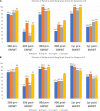One-Year Echocardiographic, Functional, and Quality of Life Outcomes After Ultrasound-Facilitated Catheter-Based Fibrinolysis for Pulmonary Embolism
- PMID: 32757658
- PMCID: PMC7434215
- DOI: 10.1161/CIRCINTERVENTIONS.120.009012
One-Year Echocardiographic, Functional, and Quality of Life Outcomes After Ultrasound-Facilitated Catheter-Based Fibrinolysis for Pulmonary Embolism
Abstract
Background: Accelerated tPA (tissue-type plasminogen activator) dosing regimens for ultrasound-facilitated, catheter-directed fibrinolysis improve short-term computed tomographic-measured right ventricular (RV)-to-left ventricular diameter ratio in massive and submassive pulmonary embolism. The impact on RV remodeling, functional status, and quality of life over the long-term remains unclear.
Methods: To study 1-year changes in RV remodeling, functional status, and quality of life, we assessed patients with acute submassive pulmonary embolism randomly assigned to 1 of 4 tPA dosing regimens for ultrasound-facilitated, catheter-directed fibrinolysis in the OPTALYSE-PE trial (Optimum Duration and Dose of r-tPA With the Acoustic Pulse Thrombolysis Procedure for Intermediate-Risk Pulmonary Embolism; 8 mg/2 hours, 8 mg/4 hours, 12 mg/6 hours, and 24 mg/6 hours). Echocardiographic assessment included RV-to-left ventricular diameter ratio within 4 hours of treatment end, and at 48 hours, 30 days, 90 days, and 1 year. Functional status was assessed by 6-minute walk test at 30 days, 90 days, and 1 year and PROMIS-PF-6b scores at 30 days, 90 days, 180 days, 270 days, and 1 year. Quality of life was evaluated by PEmb-QOL scores at 30 days, 90 days, 180 days, 270 days, and 1 year.
Results: Mean RV-to-left ventricular diameter ratio decreased from baseline to 4 hours and further at 48 hours and 30 days, with reductions maintained at 90 days and 1 year in all groups. Mean 6-minute walk distance, PROMIS-PF-6b, and PEmb-QOL scores improved over the course of 1 year in all groups.
Conclusions: Accelerated lower-dose tPA regimens for ultrasound-facilitated, catheter-directed fibrinolysis resulted in sustained recovery of RV-to-left ventricular diameter ratio and tricuspid annular plane systolic excursion and improvements in functional status and quality of life over 1 year. Registration: URL: https://www.ClinicalTrials.gov. Unique Identifier: NCT02396758.
Keywords: echocardiography; fibrinolysis; pulmonary artery; pulmonary embolism; quality of life.
Figures






References
-
- Kucher N, Boekstegers P, Müller OJ, Kupatt C, Beyer-Westendorf J, Heitzer T, Tebbe U, Horstkotte J, Müller R, Blessing E, et al. Randomized, controlled trial of ultrasound-assisted catheter-directed thrombolysis for acute intermediate-risk pulmonary embolism. Circulation. 2014;129:479–486. doi: 10.1161/CIRCULATIONAHA.113.005544. - PubMed
-
- Piazza G, Hohlfelder B, Jaff MR, Ouriel K, Engelhardt TC, Sterling KM, Jones NJ, Gurley JC, Bhatheja R, Kennedy RJ, et al. SEATTLE II Investigators. A prospective, single-arm, multicenter trial of ultrasound-facilitated, catheter-directed, low-dose fibrinolysis for acute massive and submassive pulmonary embolism: the SEATTLE II study. JACC Cardiovasc Interv. 2015;8:1382–1392. doi: 10.1016/j.jcin.2015.04.020. - PubMed
-
- Tapson VF, Sterling K, Jones N, Elder M, Tripathy U, Brower J, Maholic RL, Ross CB, Natarajan K, Fong P, et al. A randomized trial of the optimum duration of acoustic pulse thrombolysis procedure in acute intermediate-risk pulmonary embolism: the OPTALYSE PE trial. JACC Cardiovasc Interv. 2018;11:1401–1410. doi: 10.1016/j.jcin.2018.04.008. - PubMed
-
- Tu T, Toma C, Tapson VF, Adams C, Jaber WA, Silver M, Khandhar S, Amin R, Weinberg M, Engelhardt T, et al. FLARE Investigators. A prospective, single-arm, multicenter trial of catheter-directed mechanical thrombectomy for intermediate-risk acute pulmonary embolism: the FLARE study. JACC Cardiovasc Interv. 2019;12:859–869. doi: 10.1016/j.jcin.2018.12.022. - PubMed
-
- Giri J, Sista AK, Weinberg I, Kearon C, Kumbhani DJ, Desai ND, Piazza G, Gladwin MT, Chatterjee S, Kobayashi T, et al. Interventional therapies for acute pulmonary embolism: current status and principles for the development of novel evidence: a scientific statement from the American Heart Association. Circulation. 2019;140:e774–e801. doi: 10.1161/CIR.0000000000000707. - PubMed
Publication types
MeSH terms
Substances
Associated data
LinkOut - more resources
Full Text Sources
Medical

